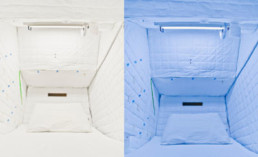New Light Technology Solves Naptime Problems for Astronauts
The biological reason for this “space insomnia” is that the body’s sleep functions are triggered by a hormone called melatonin. Melatonin is produced by the body when the eye detects darkness. Astronauts typically see 15 or 16 sunrises daily throughout their sleeping period. In the case of our intrepid space travelers, this overabundance of light disrupts their melatonin production, resulting in a restless sleep for the crew members on the International Space Station (ISS).
Photobiologists have come up with a solution to assist in this issue. After recreating the ISS sleeping quarters, researchers installed color and brightness adjustable LEDs. Volunteers were brought to take a “light-bath” as they changed the colors of the LEDs. As expected, the lower the light, the more melatonin in the volunteers, which increases the chances of falling and staying asleep.
These studies also showed which colored light would be best for sleeping and keeping the astronauts’ alert. Red-shifted light allowed volunteers to fall asleep while bluish light would wake them up. After NASA completes additional testing on whether this kind of sleep is deep enough to be restful, they plan to have LED color and brightness adjusted lighting installed in the actual crew quarters of the ISS.
Konica Minolta Sensing Americas’ precise light & display measurement products offer various styles and sizes for measuring light accurately. Konica Minolta blends cutting-edge technology with ergonomic design for light meters that are suitable for any job. Konica Minolta light meters are used in labs to measure chemically reactive substances, LEDs and OLEDs’ illumination for quality control, government testing worldwide.
Included in our product line of light meters are our illuminance color meters. These include our CL-500A, CL-200A and our CL-70F color meters. Illuminance Color Meters from Konica Minolta measure photometric brightness and provide detailed color information for light readings. These are instruments measure both color and intensity of incident lighting at a particular surface from the light source involved.
Our CL-500A Illuminance Spectrophotometer lightweight, compact illuminance spectrophotometer used for the evaluation of high-class, next-generation lamps such as LED and EL illumination. The CL-500A’ s convenient measurement functions include continuous measurement mode, display of the averaging of multiple measurements, delayed-measurement function, and the display of data at a specific wavelength.
The CL-70F, a cost-effective spectrometer-based illuminance meter, uses an accumulation type sensor to measure electronic flash. CL-70F can display color data for accurate CRI, color temperature and spectral color precision. The electronic flash measures with a PC cord connection or in cordless mode.
Visit our Lighting Industry Solutions page to learn more about our array of available instruments. Konica Minolta has a solution for all phases in the development cycle of a light source, from research and development, design, production, QA/QC, to installation and field verification.
Photo credit: Wired










